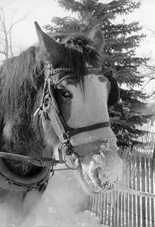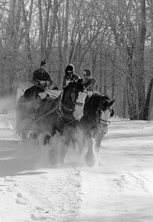

The very names of draft horse breeds have strong, ancestral sounds to them: Shire, Suffolk Punch, Percheron, Belgian and Clydesdale. Brought to North America from Europe in the 1800's, these huge powerful work horses became the pioneers of our frontier.
In the new territory, they were needed to break up the heavy prairie sod and became a fundamental part of every farm. By the turn of the century, a typical wheat farm had ten horses that worked an average of 600 hours per year. During harvest it was not unusual to see forty draft teams pulling one giant combine. However, with the increased use of motorized farm machinery in the early 1930's, the sight of draft horses, harnessed and working a field, became rare.
When Hans Hoglund acquired his homestead claim northwest of Fargo in 1871, his farm was powered by these magnificent animals. As the years went by and the wave of new technology took over the farm, the need for the farm draft horse waned. Even so, he wasn't able to completely rid his farm of these animals. He realized that he liked them. They were a living testimony to his farm.
In the early 1960's his grandson Jim Hoglund, who ran the farm from 1938 to 1985, realized this, too, when he was down to his last team of horses. "I couldn't stand seeing only them two in the barn."
That is when he decided to buy his first Clydesdale: Golden Girl, an unbroken three-year-old mare from a breeder in Iowa. He harness-broke her himself.
Why the Clydesdale?
The Clydesdale originated in the Clyde River Valley, Scotland, around 1750. They were first brought to North America around one hundred years later. Here they followed a European tradition of being hitched to beer wagons for advertising purposes. The Budweiser Clydesdales have carried on this tradition and are responsible for making them the best known draft breed.
The Clydesdale is an impressive horse. One of Hoglund's horses, Dusty, stands seventeen hands high (approximately 5 1/2 feet from his withers to his feet) and weighs about 1,800 pounds. Besides their muscular size and gently nature, their dark coloring with a white face blaze and white, heavily feathered feet make Clydesdale's definite eye catchers.

The Clydesdale is known as the "gentle giant." They once were the smallest of the draft horses but now have been bred to be bigger for show and public appeal. The Budweiser horses are among the largest. The very size of these horses is intimidating, but their temperament is not. The breed is known for being calm and docile.
"For what we're doing, I don't think you could find a better horse than the Clydesdale. I've seen kids drop down from the wagon, right in the middle, behind them, and the horses didn't even bother them," says Jim Hoglund.
Jim Hoglund is now 75 years old and retired. His son Garfield began helping him run the farm in 1985 and Garfield and his family have run the farm and the business since 1992.
And exactly what is their business with the Clydesdales?
Draft horses have been used for many jobs in the past: logging, mining, building railroads, and hauling mail and passengers. The Hoglund Clydesdales haul passengers.
The Hoglunds offer hay and sleigh rides at their farm for groups and families. They also have participated in parades and exhibitions, draft horse shows and weddings. They even took part in a funeral using a horse-drawn hearse borrowed from Bonanzaville, which they drove from Davenport to the cemetery.
"They even let the kids out of the schoolhouse to watch us go by," says Jim Hoglund.
The most rides, or the biggest group, they've ever handled was with the Fargo/Moorhead's Convention Bureau's stagecoach. Over a three-hour period, they gave rides to about 500 people.
Most of their jobs come locally. They have a contract with the Fargo Park Board to give sleigh rides in the winter at Edgewood Golf course and other locations. They have also taken their teams to Bismarck and as afar as Minneapolis to participate in parades and exhibitions.
The Hoglunds breed their Clydesdales themselves and are registered with the American Clydesdale Breeders Association of the United States. They have chosen and bought the name "Dakota" for their horses. ("Dakota" will appear as the first name in the breeder's book, whether they are traded or sold, on any of the horses they breed.)
Currently they have 11 colts. Depending on the horse market, colts can sell for anywhere from $750 to $2,500 each. They sell many of their colts to people from out of state, once as far away as Springfield, Ill.
There are still people today who use draft horses for farming.
"The farms in Illinois and Iowa are smaller and you can't bring in big machinery," says Garfield.
Each sale is a little difficult for these compassionate horse lovers.
"It's terrible to get rid of them," says Garfield Hoglund. "That's why we have so many."
Through breeding, selling and commissioning their services brings in some money, Garfield also holds down a regular job with the railroad. His grandfather and namesake, Garfield (Hans's son), also worked for the railroad before coming to the farm.
The care for the Clydesdale, as with most of the draft horses, is minimal. The breeds are quite hardy. A call to the vet is an unusual event, occurring only when a mare is foaling (giving birth). Clydesdales, much like pets, need the yearly shots for basic prevention. The Hoglunds are able to give the horses their routine shots themselves.
Garfield's Clydesdales go through a round, thousand-pound bale of hay in about three days. (That's about a bale of hay a day, per horse) He also supplements their diet with oats and grain. He puts up his own hay for the horses, but may have to buy hay for the first time this year because of the cold weather. His horses are outside all of the time (except for bad storms) and they need the extra feed to fend off the cold. The bales also help act as a wind block.
Because of their big size, the Clydesdales sometimes don't know their own strength.
"I remember when I was a kid," says Garfield, "Dad always brought the horses in every night. You'd usually feed them outside and then let them in. Your feet would get cold and occasionally one would step on you. And then they'd kinda look at you when you started hitting them. 'What ya hitting me for?' You know?"
Sometimes their strength can be a cause of tragedy. Both Jim and Garfield have lost horses when their halters have gotten caught on machinery. One pulled a round bale feeder down on top of himself and another pulled a wagon down that had been put up on barrels. Both horses were killed.
Jim had one, two winters ago, that died out in the yard. He thinks it was probably a heart attack.
"I just sat out there and bawled,"says Jim.
Garfield, 42, his wife Mary, 38, their children Sari, 20, James, 18, and Elizabeth, 15, are all very involved with horses. They all get a chance to help when it comes to doing the hay or sleigh rides and the assorted chores that go with having horses. They even bottle fed a colt until it was able to eat on its own. Mary says that's one colt she'll never want Garfield to sell.

As in earlier days, these horses have proven vital at times. They've hauled cars and trucks out from the ditches and helped more animals back to the barn when they become ill in the pasture. The Hoglund home is heated by a wood furnace and the horses have been a blessing when it came to hauling the logs in from their land.
Will the next generation carry on the Hoglund legacy? Will they be able to continue sharing a bit of farming heritage to our area? Do they have the same compassion that can be seen and heard from their father and grandfather?
"Oh, yes," says Mary. "My father-in-law wants my oldest daughter, Sari, to buy his farm. TheyÍre all horse crazy."
Can this family see how they reflect the very qualities in themselves that this Clydesdale horse is known for?
If they don't, that's all right--others will.
Story by Claudia Hansen
Photography by Brad Clemenson
Design by Trish Magnus and Kate Volk